Towards Circular Economy in the Agri-Food Sector. A Systematic Literature Review
Abstract
1. Introduction
- RQ1:
- How does the research analyse the CE as applied to the AFS?
- RQ2:
- What are the possible scenarios and lines of future research?
2. Materials and Methods
2.1. Locating Studies
2.2. Study Selection and Evaluation
- Conceptual studies based on CE applied to AFS;
- Conceptual and empirical studies that explore the use of life cycle assessment in AFS or provide a Life Cycle Assessment (LCA), Social Life Cycle Assessment (S-LCA) or Life Cycle Costing (LCC) analysis on a food product aimed at studying the development of the CE in the AFS;
- Conceptual and empirical studies that analyse problems of food waste and food loss during the whole agro-food supply chain.
- Empirical studies on the CE concerning chemistry, biology and biotechnology focusing more on the nutritional and organoleptic characteristics of food and not aimed at the research objectives;
- Conceptual and empirical studies that exclusively analyse the environmental impact of a food production system.
2.3. Analysis and Synthesis
- Country of Research,
- Research Methods,
- Scientific Field,
- Focus on Tools Implemented,
- Focus on Type of SC and
- SC Stage.
3. Descriptive Analysis
4. Research on the Circular Economy Applied to the Agro-Food Sector: The State-of-the-Art Research
4.1. Country of Research
4.2. Research Methods
4.3. Scientific Field
4.4. Focus on Tools Implemented
4.5. Focus on the Type of the Agro-Food Supply Chain
4.6. Focus on the Stage of the Agro-Food Supply Chain
4.7. Comparative Analysis between the Environmental Assessment Tools Implemented and Type of Supply Chain
5. Discussion
6. Conclusions
Author Contributions
Funding
Conflicts of Interest
References
- Ellen MacArthur Foundation. Towards the Circular Economy Vol.1: An Economic and Business Rationale for an Accelerated Transition; Ellen MacArthur Foundation: Cowes, UK, 2013. [Google Scholar]
- Lieder, M.; Rashid, A. Towards circular economy implementation: A comprehensive review in context of manufacturing industry. J. Clean. Prod. 2016, 115, 36–51. [Google Scholar] [CrossRef]
- Merli, R.; Preziosi, M.; Acampora, A. How do scholars approach the circular economy? A systematic literature review. J. Clean. Prod. 2017, 178, 703–722. [Google Scholar] [CrossRef]
- Food and Agriculture Organization of the United Nations. The State of Food and Agriculture, Moving Forward on Food Loss and Waste Reduction; Food and Agriculture Organization of the United Nations: Rome, Italy, 2019. [Google Scholar]
- Proto, M.; Malandrino, O.; Supino, S. Sistemi e strumenti di gestione per la qualità. In Percorsi Evolutivi e Approcci Manageriali—University of Salerno; Giappichelli Editore: Turin, Italy, 2008. [Google Scholar]
- Taghikhah, F.; Voinov, A.; Shukla, N. Extending the supply chain to address sustainability. J. Clean. Prod. 2019, 229, 652–666. [Google Scholar] [CrossRef]
- Sica, D.; Malandrino, O.; Supino, S. The Corporate Social Responsibility in the Italian Agro-food Sector. J. Health Sci. 2018, 6, 358–364. [Google Scholar] [CrossRef]
- Geng, Y.; Doberstein, B. Developing the circular economy in China: Challenges and opportunities for achieving ‘leapfrog development’. Int. J. Sustain. Dev. World Ecol. 2008, 15, 231–239. [Google Scholar] [CrossRef]
- Zhang, X.X.; Ma, F.; Wang, L. Application of Life Cycle Assessment in Agricultural Circular Economy. Appl. Mech. Mater. 2018, 260–261, 1086–1091. [Google Scholar] [CrossRef]
- Aznar-Sánchez, J.A.; Velasco-Muñoz, J.F.; López-Felices, B.; del Moral-Torres, F. Barriers and Facilitators for Adopting Sustainable Soil Management Practices in Mediterranean Olive Groves. Agronomy 2020, 10, 506. [Google Scholar] [CrossRef]
- Denyer, D.; Tranfield, D. Using qualitative research synthesis to build an actionable knowledge base. Manag. Decis. 2008, 44, 213–227. [Google Scholar] [CrossRef]
- Masi, D.; Day, S.; Godsell, J. SC Configurations in the Circular Economy: A Systematic Literature Review. Sustainability 2017, 9, 1602. [Google Scholar] [CrossRef]
- Bisogno, M.; Dumay, J.; Manes Rossi, F.; Tartaglia Polcini, P. Identifying future directions for IC research in education: A literature review. J. Clean. Prod. 2018, 19, 10–33. [Google Scholar] [CrossRef]
- Tranfield, D.; Denyer, D.; Smart, P. Towards a methodology for developing evidence-informed management knowledge by means of systematic review. Br. J. Manag. 2003, 14, 207–222. [Google Scholar] [CrossRef]
- Sauvé, S.; Bernard, S.; Sloan, P. Environmental sciences, sustainable development and circular economy: Alternative concepts for trans-disciplinary research. Environ. Dev. 2016, 17, 48–56. [Google Scholar] [CrossRef]
- Petticrew, M.; Roberts, H. Systematic Reviews in the Social Sciences: A Practical Guide; Wiley-Blackwell: Oxford, UK, 2008. [Google Scholar]
- Manes-Rossi, F.; Nicolò, G.; Argento, D. Non-financial reporting formats in public sector organizations: A structured literature review. J. Public Budg. Account. Financ. Manag. 2020, in press. [Google Scholar] [CrossRef]
- Rizos, V.; Tuokko, T.; Behrens, A. The Circular Economy: A Review of Definitions Processes and Impacts. CEPS Research Report No 2017/8. Available online: https://www.ceps.eu/publications/circular-economy-review-definitions-processes-and-impacts (accessed on 27 March 2020).
- Boulding, K.E. The economics of knowledge and the knowledge of economics. Am. Econ. Rev. 1966, 56, 1–13. [Google Scholar]
- Frosch, R.; Gallopoulos, N. Strategies for manufacturing. Sci. Am. 1989, 261, 144–152. [Google Scholar] [CrossRef]
- Garner, A.; Keoleian, G.A. Industrial Ecology: An Introduction, Pollution Prevention and Industrial Ecology Series, National Pollution Prevention Center for Higher Education; University of Michigan: Ann Arbor, MI, USA, 1995; pp. 1–32. [Google Scholar]
- Ayres, R.U. Industrial metabolism and global change. Soc. Sci. J. 1989, 41, 363–373. [Google Scholar]
- Chertow, M. Industrial symbiosis: Literature and taxonomy. Ann. Rev. Energy Environ. 2000, 25, 313–337. [Google Scholar] [CrossRef]
- Braungart, M.; McDonough, W.; Bollinger, A. Cradle-to-cradle design: Creating healthy emissions—A strategy for eco-effective product and system design. J. Clean. Prod. 2007, 15, 1337–1348. [Google Scholar] [CrossRef]
- Ankrah, N.A.; Manu, E.; Booth, C. Beyond sustainable buildings: Eco-efficiency to eco-effectiveness through cradle-to-cradle design. In Proceedings of the 7th International Conference on Sustainability in Energy and Buildings, Lisbon, Portugal, 1–5 July 2015. [Google Scholar]
- European Commission. Proposal for a Regulation of the European Parliament and of the Council on the Establishment of a Framework to Facilitate Sustainable Investment; European Commission: Brussels, Belgium, 2015. [Google Scholar]
- Petit, G.; Sablayrolles, C.; Yannou-Le Bris, G. Combining eco-social and environmental indicators to assess the sustainability performance of a food value chain: A case study. J. Clean. Prod. 2018, 191, 135–143. [Google Scholar] [CrossRef]
- European Commission. Communication from the commission to the European parliament, the council, the european economic and social committee and the committee of the regions. In Towards a circular economy: A zero waste programme for Europe; European Commission: Brussels, Belgium, 2014. [Google Scholar]
- European Commission. Communication from the commission to the European parliament, the council, the European economic and social committee and the committee of the regions. In Closing the Loop—An EU Action Plan for the Circular Economy; European Commission: Brussels, Belgium, 2015. [Google Scholar]
- Ellen MacArthur Foundation. Towards the Circular Economy: Opportunities for the Consumer Goods Sector; Ellen MacArthur Found: Cowes, UK, 2013; Volume 2, pp. 1–112. [Google Scholar]
- Ghisellini, P.; Ulgiati, S. Circular economy transition in Italy. Achievements, perspectives and constraints. J. Clean. Prod. 2020, 243, 118360. [Google Scholar] [CrossRef]
- Su, B.; Heshmati, A.; Geng, Y.; Yu, X. A review of the circular economy in China: Moving from rhetoric to implementation. J. Clean. Prod. 2013, 42, 215–227. [Google Scholar] [CrossRef]
- Yuan, Z.; Bi, J.; Moriguichi, Y. The Circular Economy: A New Development Strategy in China. J. Ind. Ecol. 2006, 10, 4–8. [Google Scholar] [CrossRef]
- Donner, M.; Gohier, R.; de Vries, H. A new circular business model typology for creating value from agro-waste. Sci. Total. Environ. 2020, 716, 137065. [Google Scholar] [CrossRef] [PubMed]
- Ward, S.M.; Holden, N.M.; White, E.P.; Oldfield, T.L. The “circular economy” applied to the agriculture (livestock production) sector—Discussion paper. Food industry. In Proceedings of the Workshop on the Sustainability of the EU’s Livestock Production Systems, European Commission, DG Agriculture and Rural Development, Brussels, Belgium, 14–15 September 2016; Volume 12. [Google Scholar]
- Grönroos, J.; Seppälä, J.; Voutilainen, P.; Seuri, P.; Koikkalainen, K. Energy use in conventional and organic milk and rye bread production in Finland. Agr. Ecosyst. Environ. 2006, 117, 109–118. [Google Scholar] [CrossRef]
- Martínez-Blanco, J.; Muñoz, P.; Antón, A.; Rieradevall, J. Life cycle assessment of the use of compost from municipal organic waste for fertilization of tomato crops. Resour. Conserv. Recycl. 2009, 53, 340–351. [Google Scholar] [CrossRef]
- Arzoumanidis, I.; Raggi, A.; Petti, L. Considerations When Applying Simplified LCA Approaches in the Wine Sector. Sustainability 2014, 6, 5018–5028. [Google Scholar] [CrossRef]
- Falcone, G.; De Luca, A.I.; Stillitano, T.; Strano, A.; Romeo, G.; Gulisano, G. Assessment of Environmental and Economic Impacts of Vine-Growing Combining Life Cycle Assessment, Life Cycle Costing and Multicriterial Analysis. Sustainability 2016, 8, 793. [Google Scholar] [CrossRef]
- Mondello, G.; Salomone, R.; Ioppolo, G.; Saija, G.; Sparacia, S.; Lucchetti, M.C. Comparative LCA of Alternative Scenarios for Waste Treatment: The Case of Food Waste Production by the Mass-Retail Sector. Sustainability 2017, 9, 827. [Google Scholar] [CrossRef]
- Borrello, M.; Caracciolo, F.; Lombardi, A.; Pascucci, S.; Cembalo, L. Consumers’ Perspective on Circular Economy Strategy for Reducing Food Waste. Sustainability 2017, 9, 141. [Google Scholar] [CrossRef]
- Vittuari, M.; De Menna, F.; Gaiani, S.; Falasconi, L.; Politano, A.; Dietershagen, J.; Segrè, A. The Second Life of Food: An Assessment of the Social Impact of Food Redistribution Activities in Emilia Romagna, Italy. Sustainability 2017, 9, 1817. [Google Scholar] [CrossRef]
- Raimondo, M.; Caracciolo, F.; Cembalo, L.; Chinnici, G.; Pecorino, B.; D’Amico, M. Making Virtue Out of Necessity: Managing the Citrus Waste Supply Chain for Bioeconomy Applications. Sustainability 2018, 10, 4821. [Google Scholar] [CrossRef]
- Murray, A.; Skene, K.; Haynes, K. The Circular Economy: An Interdisciplinary Exploration of the Concept and Application in a Global Context. J. Bus. Ethics 2017, 140, 369–380. [Google Scholar] [CrossRef]
- Kajikawa, Y.; Tacoa, F.; Yamaguchi, K. Sustainability science: The changing landscape of sustainability research. Sustain. Sci. 2014, 9, 431–438. [Google Scholar] [CrossRef]
- Sassanelli, C.; Rosa, P.; Rocca, R.; Terzi, S. Circular Economy performance assessment methods: A systematic literature review. J. Clean. Prod. 2020, 229, 440–453. [Google Scholar] [CrossRef]
- Salomone, R.; Ioppolo, G. Environmental impacts of olive oil production: A Life Cycle Assessment case study in the province of Messina (Sicily). J. Clean. Prod. 2018, 28, 88–100. [Google Scholar] [CrossRef]
- Gava, O.; Bartolini, F.; Venturi, F.; Brunori, G.; Zinnai, A.; Pardossi, A. A Reflection of the Use of the Life Cycle Assessment Tool for Agro-food Sustainability. Sustainability 2019, 11, 71. [Google Scholar] [CrossRef]
- Warshawsky, D.N. The Challenge of Food Waste Governance in Cities: Case Study of Consumer Perspectives in Los Angeles. Sustainability 2019, 11, 847. [Google Scholar] [CrossRef]
- Haupt, M.; Zschokke, M. How can LCA support the circular economy?—63rd discussion forum on life cycle assessment, Zurich, Switzerland, 20 November 2016. Int. J. Life Cycle Assess 2017, 22, 832–837. [Google Scholar] [CrossRef]
- Lupia, F.; Baiocchi, V.; Lelo, K.; Pulighe, G. Exploring Rooftop Rainwater Harvesting Potential for Food Production in Urban Areas. Agriculture 2017, 7, 46. [Google Scholar] [CrossRef]
- Castrica, M.; Tedesco, D.E.A.; Panseri, S.; Ferrazzi, G.; Ventura, V.; Frisio, D.G.; Balzaretti, C.M. Pet Food as the Most Concrete Strategy for Using Food Waste as Feedstuff within the European Context: A Feasibility Study. Sustainability 2018, 10, 2035. [Google Scholar] [CrossRef]
- Serrapica, F.; Masucci, F.; Raffrenato, E.; Sannino, M.; Vastolo, A.; Barone, C.M.A.; Di Francia, A. High Fiber Cakes from Mediterranean Multipurpose Oilseeds as Protein Sources for Ruminants. Animals 2019, 9, 918. [Google Scholar] [CrossRef] [PubMed]
- Bas-Bellver, C.; Barrera, C.; Betoret, N.; Seguí, L. Turning Agro-food Cooperative Vegetable Residues into Functional Powdered Ingredients for the Food Industry. Sustainability 2020, 12, 1284. [Google Scholar] [CrossRef]
- Ferri, M.; Vannini, M.; Ehrnell, M.; Eliasson, L.; Xanthakis, E.; Monari, S.; Sisti, L.; Marchese, P.; Celli, A.; Tassoni, A. From winery waste to bioactive compounds and new polymeric biocomposites: A contribution to the circular economy concept. J. Adv. Res. 2020, 24, 1–11. [Google Scholar] [CrossRef] [PubMed]
- Tseng, M.-L.; Tan, R.; Chiu, A.S.F.; Chien, C.-F.; Kuo, T.C. Circular economy meets industry 4.0: Can big data drive industrial symbiosis? Resour. Conserv. Recycl. 2018, 131, 146–147. [Google Scholar] [CrossRef]
- Rosa, P.; Sassanelli, C.; Urbinati, A.; Chiaroni, D.; Terzi, S. Assessing relations between Circular Economy and Industry 4.0: A systematic literature review. Int. J. Prod. 2020, 58, 1662–1687. [Google Scholar] [CrossRef]
- Routroy, S.; Behera, A. Agriculture SC: A systematic review of literature and implications for future research. J. Agribus. Dev. Emerg. Econ. 2016, 7, 275–302. [Google Scholar] [CrossRef]
- Jurgilevich, A.; Birge, T.; Kentala-Lehtonen, J.; Korhonen-Kurki, K.; Pietikäinen, J.; Saikku, L.; Schösler, H. Transition towards Circular Economy in the Food System. Sustainability 2016, 8, 69. [Google Scholar] [CrossRef]
- Aivazidou, E.; Tsolakis, N. A water footprint review of Italian wine: Drivers, barriers, and practices for sustainable stewardship. Water 2020, 12, 369. [Google Scholar] [CrossRef]
- Stillitano, T.; Falcone, G.; De Luca, A.I.; Piga, A.; Conte, P.; Strano, A.; Gulisano, G. A life cycle perspective to assess the environmental and economic impacts of innovative technologies in extra virgin olive oil extraction. Foods 2019, 8, 209. [Google Scholar] [CrossRef]
- Bava, L.; Bacenetti, J.; Gislon, G.; Pellegrino, L.; D’Incecco, P.; Sandrucci, A.; Tamburini, A.; Fiala, M.; Zucali, M. Impact assessment of traditional food manufacturing: The case of Grana Padano cheese. Sci. Total Environ. 2018, 626, 1200–1209. [Google Scholar] [CrossRef]
- Georganas, A.; Giamouri, E.; Pappas, A.C.; Papadomichelakis, G.; Galliou, F.; Manios, T.; Tsiplakou, E.; Fegeros, K.; Zervas, G. Bioactive Compounds in Food Waste: A Review on the Transformation of Food Waste to Animal Feed. Foods 2020, 9, 291. [Google Scholar] [CrossRef] [PubMed]
- Pohlmann, C.R.; Scavarda, A.J.; Alves, M.B.; Korzenowski, A.L. The role of the focal company in sustainable development goals: A Brazilian food poultry supply chain case study. J. Clean. Prod. 2020, 245, 118798. [Google Scholar] [CrossRef]
- García-Gudiño, J.; Monteiro, A.N.T.R.; Espagnol, S.; Blanco-Penedo, I.; Garcia-Launay, F. Life Cycle Assessment of Iberian Traditional Pig Production System in Spain. Sustainability 2020, 12, 627. [Google Scholar] [CrossRef]
- Presumido, P.H.; Sousa, F.; Gonçalves, A.; Dal Bosco, T.C.; Feliciano, M. Environmental Impacts of the Beef Production Chain in the Northeast of Portugal Using Life Cycle Assessment. Agriculture 2018, 8, 165. [Google Scholar] [CrossRef]
- Aidonis, D.; Folinas, D.; Achillas, C.; Triantafyllou, D.; Malindretos, G. Multi-criteria evaluation of sustainable supply chains in the agrifood sector. Int. J. Sustain. Agric. Manag. Inform. 2015, 1, 106–119. [Google Scholar] [CrossRef]
- De Menna, F.; Davis, J.; Östergren, K.; Unger, N.; Loubiere, M.; Vittuari, M. A combined framework for the life cycle assessment and costing of food waste prevention and valorization: An application to school canteens. AIMS Agric. Food 2020, 8, 1–11. [Google Scholar] [CrossRef]
- Caputo, P.; Ducoli, C.; Clementi, M. Strategies and Tools for Eco-Efficient Local Food Supply Scenarios. Sustainability 2014, 6, 631–651. [Google Scholar] [CrossRef]
- Davies, F.T.; Garrett, B. Technology for Sustainable Urban Food Ecosystems in the Developing World: Strengthening the Nexus of Food–Water–Energy–Nutrition. Front. Sustain. Food Syst. 2018, 2, 84. [Google Scholar] [CrossRef]
- Canali, M.; Amani, P.; Aramyan, L.; Gheoldus, M.; Moates, G.; Östergren, K.; Silvennoinen, K.; Waldron, K.; Vittuari, M. Food Waste Drivers in Europe, from Identification to Possible Interventions. Sustainability 2017, 9, 37. [Google Scholar] [CrossRef]
- Mouron, P.; Willersinn, C.; Möbius, S.; Lansche, J. Environmental profile of the Swiss SC for French fries: Effects of food loss reduction, loss treatments and process modifications. Sustainability 2016, 8, 1214. [Google Scholar] [CrossRef]
- Oldfield, T.L.; White, E.; Holden, N.M. The implications of stakeholder perspective for LCA of wasted food and green waste. J. Clean. Prod. 2018, 170, 1554–1564. [Google Scholar] [CrossRef]
- Morales-Polo, C.; Cledera-Castro, M.D.M.; Moratilla Soria, B.Y. Reviewing the anaerobic digestion of food waste: From waste generation and anaerobic process to its perspectives. Appl. Sci. 2018, 8, 1804. [Google Scholar] [CrossRef]
- Bacenetti, J.; Restuccia, A.; Schillaci, G.; Failla, S. Biodiesel production from unconventional oilseed crops (Linum usitatissimum L. and Camelina sativa L.) in Mediterranean conditions: Environmental sustainability assessment. Renew. Energy 2017, 112, 444–456. [Google Scholar] [CrossRef]
- Yakovleva, N. Measuring the sustainability of the food supply chain: A case study of the UK. J. Environ. Policy Plan. 2007, 9, 75–100. [Google Scholar] [CrossRef]
- Antonelli, M.; Ruini, L.F. Business Engagement with Sustainable Water Resource Management through Water Footprint Accounting: The Case of the Barilla Company. Sustainability 2015, 7, 6742–6758. [Google Scholar] [CrossRef]
- Balafoutis, A.T.; Koundouras, S.; Anastasiou, E.; Fountas, S.; Arvanitis, K. Life Cycle Assessment of Two Vineyards after the Application of Precision Viticulture Techniques: A Case Study. Sustainability 2017, 9, 1997. [Google Scholar] [CrossRef]
- Wang, H.; Yang, Y.; Zhang, X.; Tian, G. Carbon Footprint Analysis for Mechanization of Maize Production Based on Life Cycle Assessment: A Case Study in Jilin Province, China. Sustainability 2015, 7, 15772–15784. [Google Scholar] [CrossRef]
- Martucci, O.; Arcese, G.; Montauti, C.; Acampora, A. Social Aspects in the Wine Sector: Comparison between Social Life Cycle Assessment and VIVA Sustainable Wine Project Indicators. Resources 2019, 8, 69. [Google Scholar] [CrossRef]
- Savastano, S. Shaping a Holistic Response to COVID-19: Protecting Food Systems and Rural Producers. IFAD. 2020. Available online: https://www.ifad.org/en/web/latest/blog/asset/41863743 (accessed on 21 May 2020).
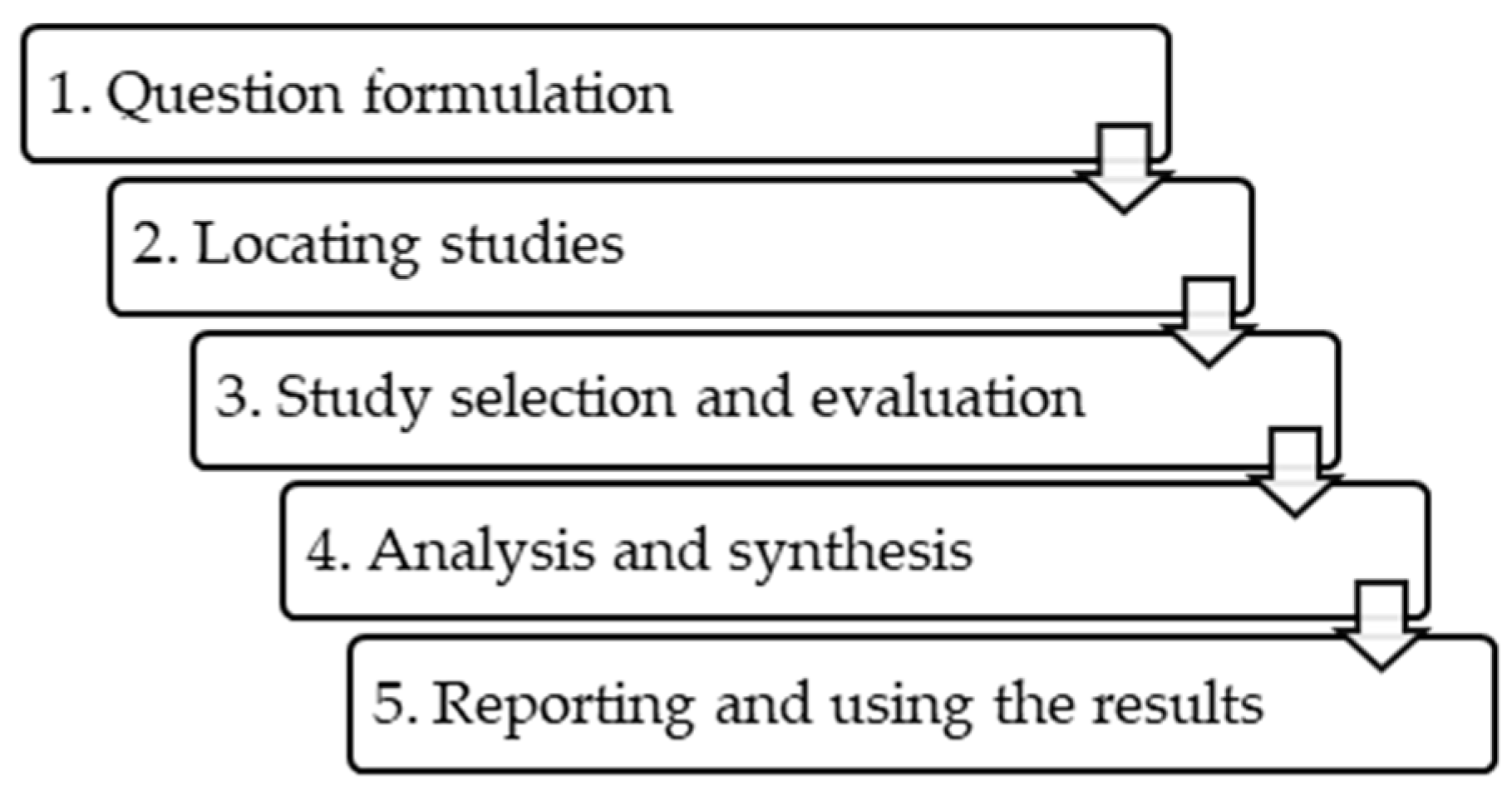
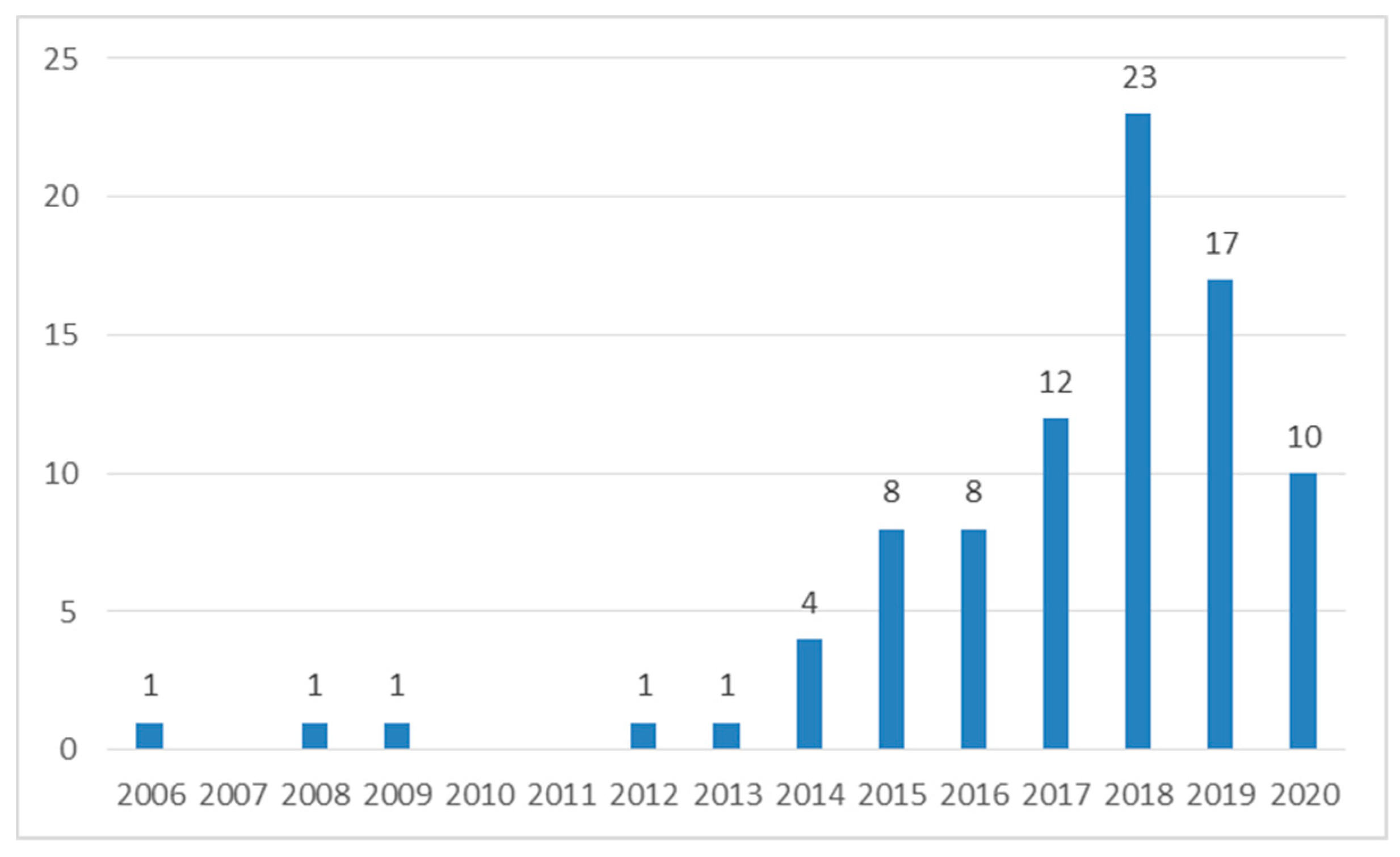

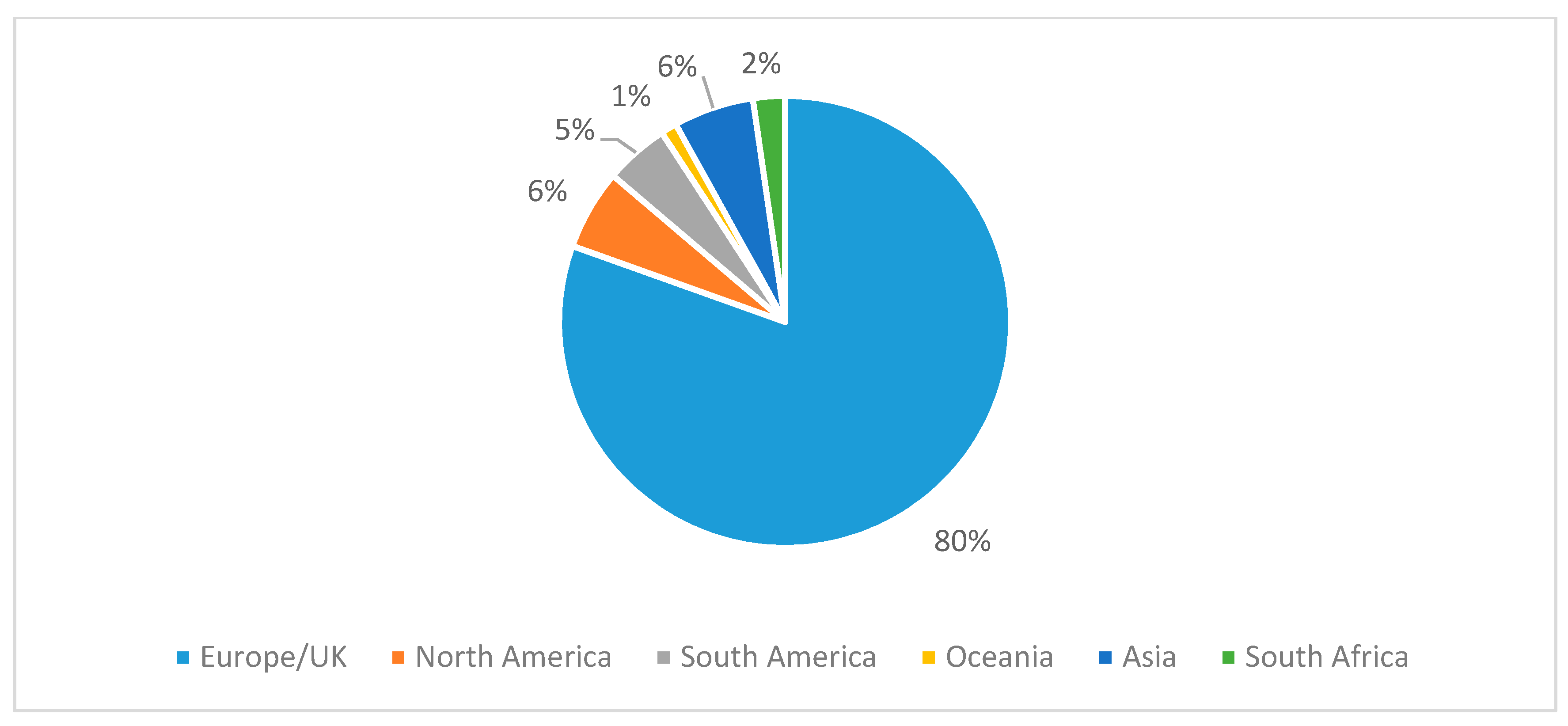
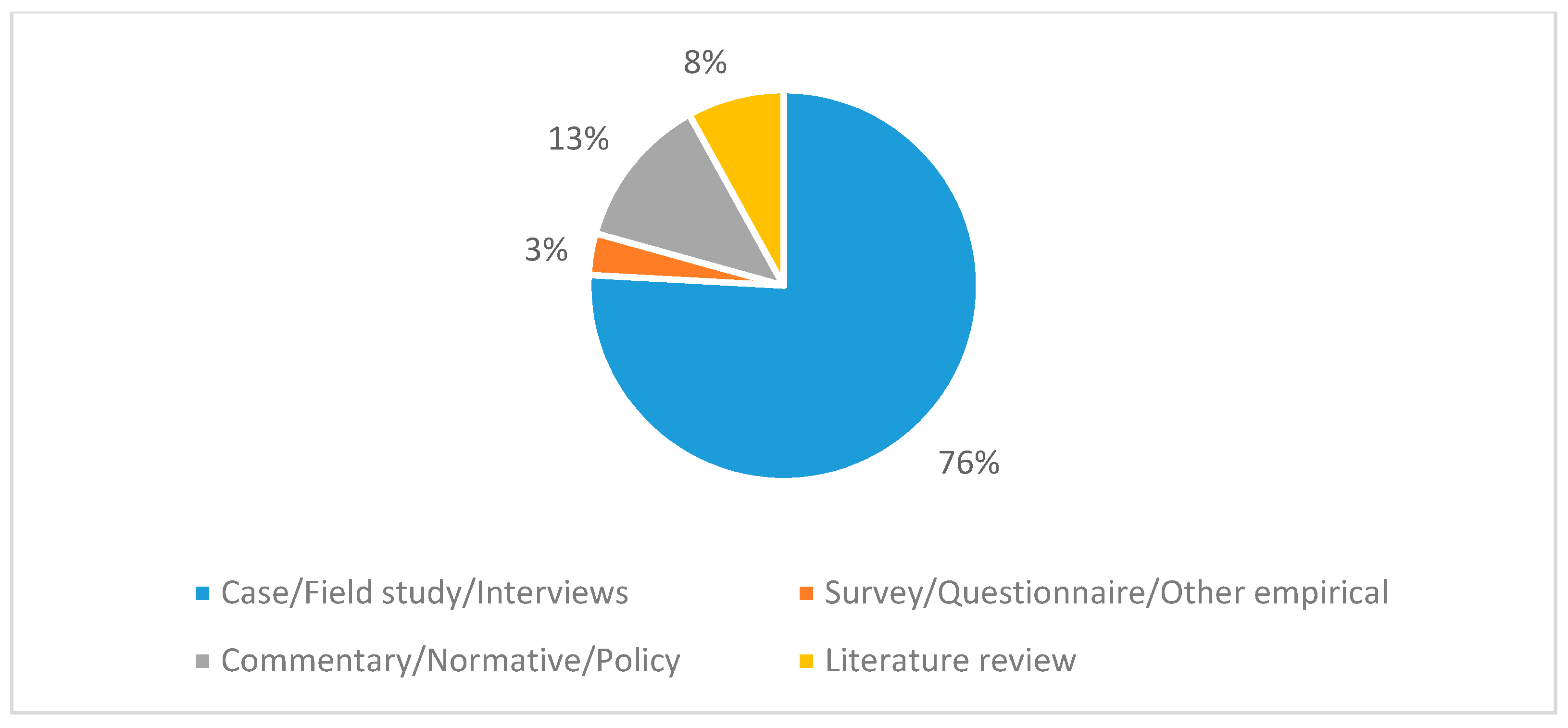
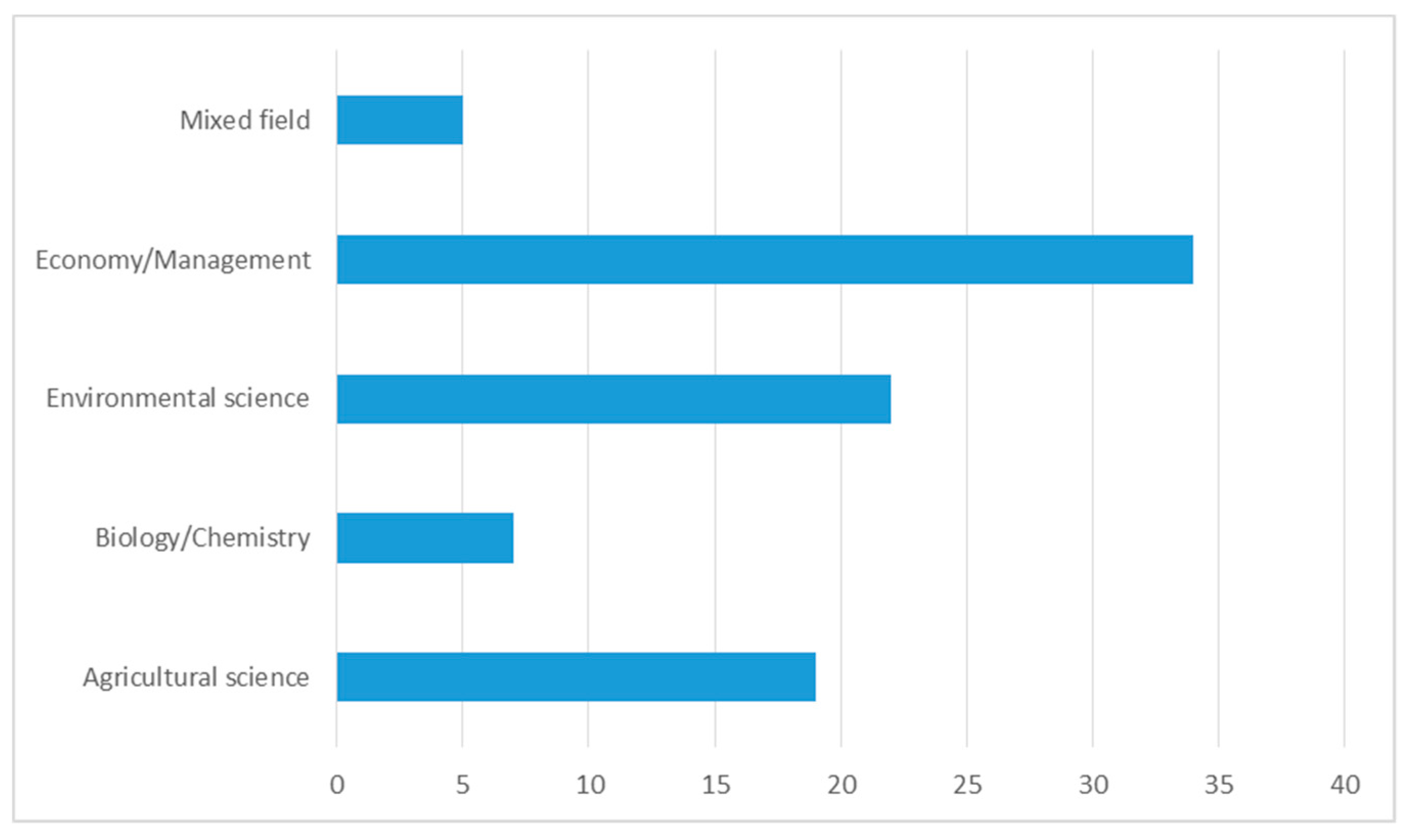
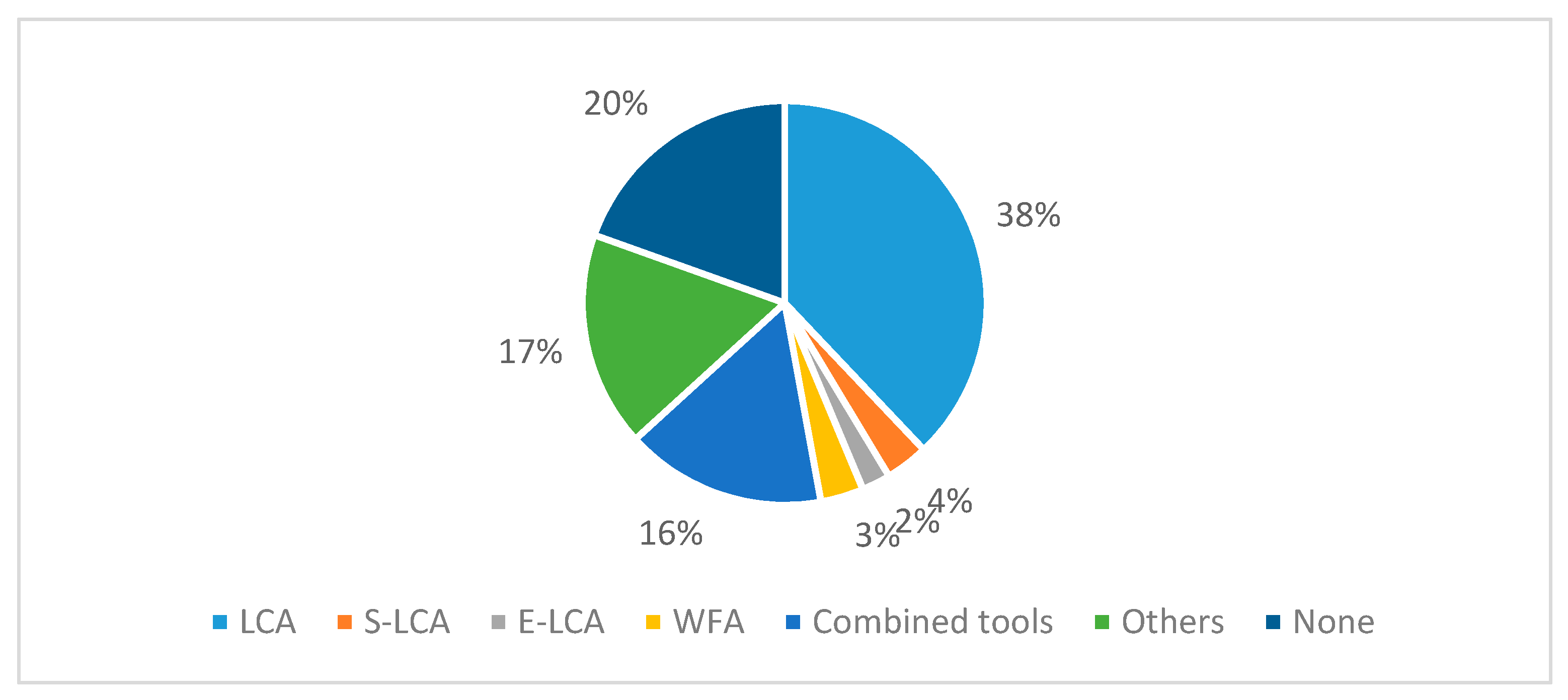
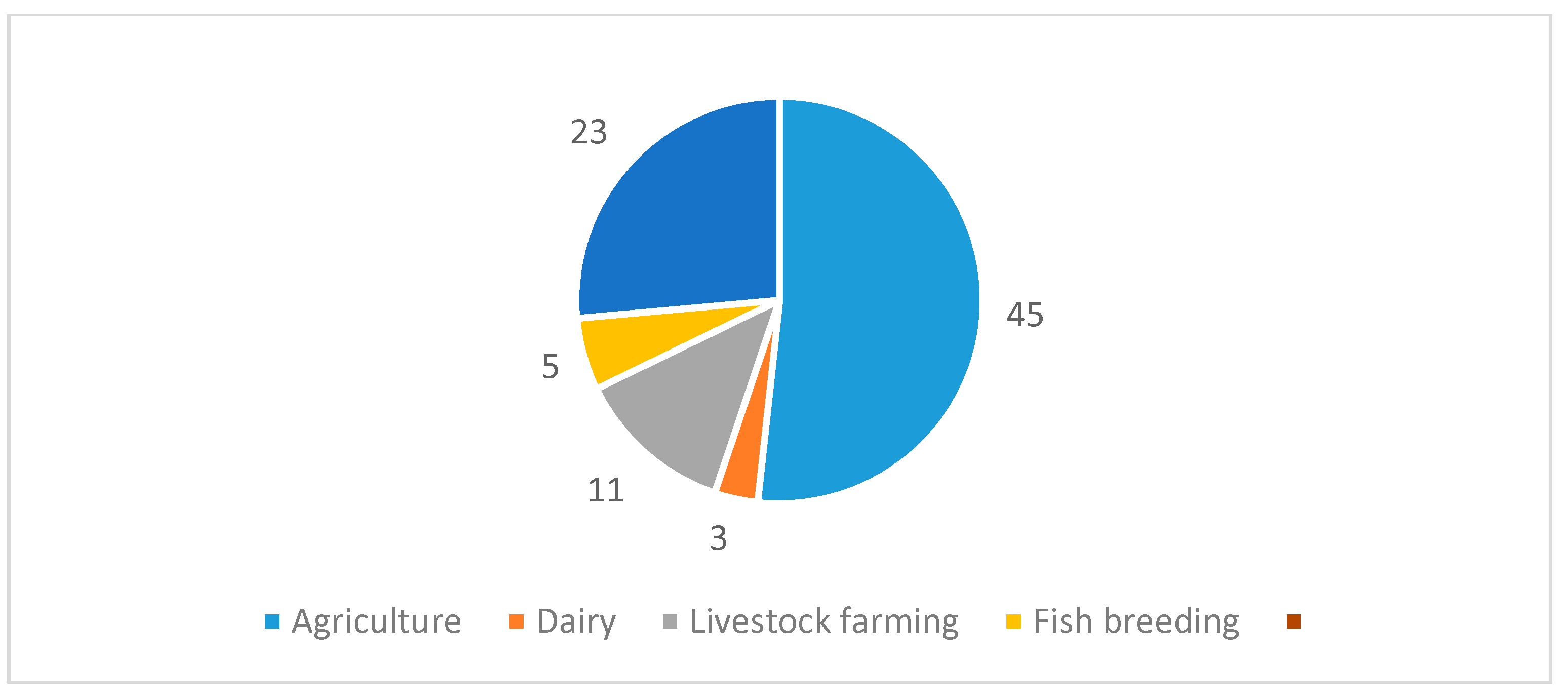
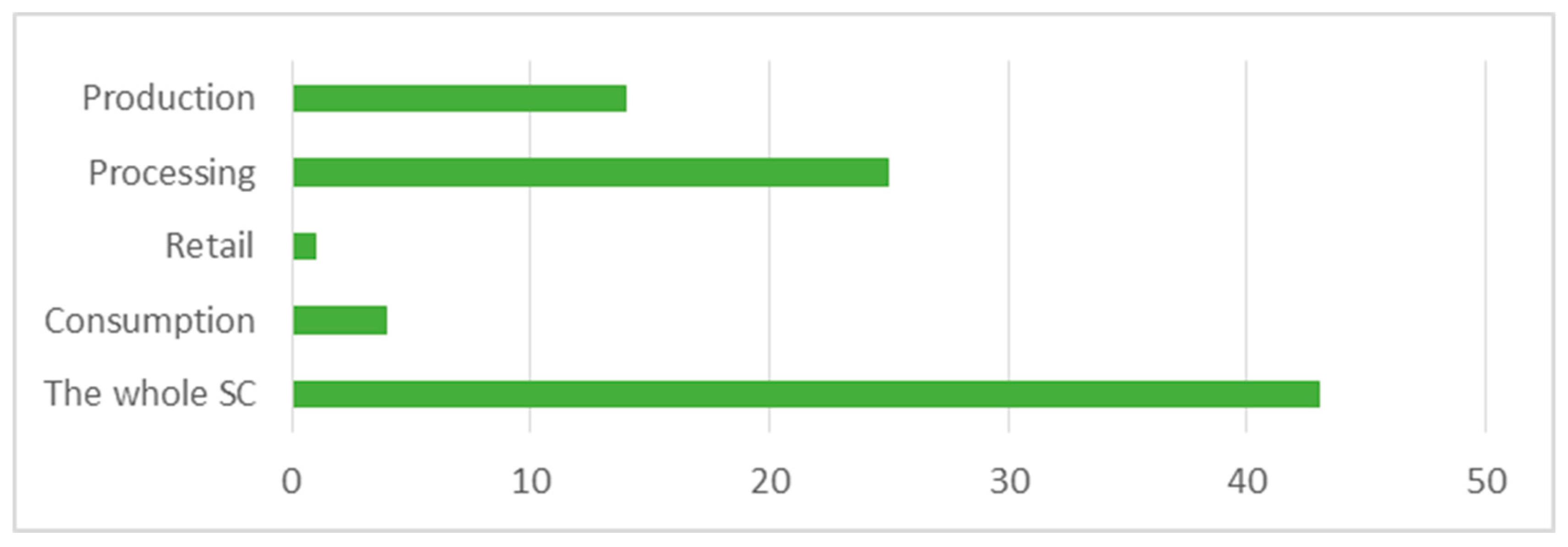
| Database | Search String | Application |
|---|---|---|
| SCOPUS | ALL (“Agro-food sector” AND (“Circular Economy” OR “Life Cycle Assessment” OR “Food waste”)) | The search fields were Title, Abstract and Keywords. The database retrieved 596 articles. |
| WEB OF SCIENCE | (Agro-food AND (“Circular Economy” OR “Life Cycle Assessment” OR “Food waste”)) | The search was made in all field. The database retrieved 28 articles. |
| SCIENCE DIRECT | (“Agro-food sector” AND (“Circular economy” OR “Life cycle assessment” OR “Food waste”)) | The search fields were Title, Abstract and Keywords. The database retrieved 191 articles. |
| Sample | Number of Articles |
|---|---|
| 1. Articles from search strings in database (WoS 375 + SC 596 + SD191) | 815 |
| 2. Duplicated articles removed | −120 |
| 3. Contributions concerning other fields (title and abstract screening) | −230 |
| 4. Contributions not committed to the purpose of the paper (full text screening) | −230 |
| Final sample | 87 |
| Code | Journal Name | No. |
|---|---|---|
| SUST | Sustainability | 37 |
| JCP | Journal of Cleaner Production | 10 |
| RCR | Resources, Conservation and Recycling | 2 |
| WT | Water | 2 |
| AGR | Agriculture | 2 |
| ENG | Energies | 4 |
| STE | Science of the Total Environment | 3 |
| NUT | Nutrients | 2 |
| FDS | Foods | 3 |
| RSC | Resources | 2 |
| OTH | Others | 20 |
| Total | 87 |
| A. | Country of Research | No. | % | B. | Research Methods | No. | % |
| A1 | Europe/UK | 27 | 80.00 | B1 | Case/Field study/Interviews | 66 | 76.00 |
| A2 | North America | 5 | 6.00 | B2 | Survey/Questionnaire/Other empirical | 3 | 3.00 |
| A3 | South America | 4 | 5.00 | B3 | Commentary/Normative/Policy | 11 | 13.00 |
| A4 | Oceania | 1 | 1.00 | B4 | Literature review | 7 | 8.00 |
| A5 | Asia | 5 | 6.00 | Total | 87 | 100 | |
| A6 | Africa | 2 | 2.00 | ||||
| Total | 87 | 100 | |||||
| C. | Scientific Field | No. | % | D. | Focus on Tools Implemented | No. | % |
| C1 | Agricultural science | 19 | 21.84 | D1 | LCA | 33 | 37.93 |
| C2 | Biology/Chemistry | 7 | 8.04 | D2 | S-LCA | 3 | 3.45 |
| C3 | Environmental science | 22 | 25.29 | D3 | E-LCA | 2 | 2.30 |
| C4 | Economy/Management | 34 | 39.08 | D4 | WFA | 3 | 3.45 |
| Mixed fields | 5 | 5.75 | D5 | Combined tools | 14 | 16.10 | |
| Total | 87 | 100 | D6 | Others | 15 | 17.24 | |
| D7 | None | 17 | 19.54 | ||||
| Total | 87 | 100 | |||||
| E. | Focus on Type of SC | No. | % | F. | SC Stage | No. | % |
| E1 | Agriculture | 45 | 51.72 | F1 | Production | 14 | 16.10 |
| E2 | Dairy | 3 | 3.45 | F2 | Processing | 25 | 28.73 |
| E3 | Livestock farming | 11 | 12.65 | Retail | 1 | 1.15 | |
| E4 | Fish breeding | 5 | 5.75 | F3 | Consumption | 4 | 4.60 |
| E5 | Various | 23 | 26.43 | F4 | The whole SC | 43 | 49.42 |
| E6 | Total | 87 | 100 | F5 | Total | 87 | 100 |
| Authors | Geographical Location | Supply Chain | Product | Tool | Industrial Symbiosis Dimension |
|---|---|---|---|---|---|
| Martínez-Blanco et al. (2009) | Barcelona | Agriculture | Tomato | LCA | Meso |
| Arnal et al. (2018) | Italy | Agriculture | Tomato | LCA | Meso |
| Mouron et al. (2016) | Swiss | Agriculture | Potato | LCA | Meso |
| Salomone and Ioppolo (2012) | Sicily | Agriculture | Olive oil | LCA | Micro |
| Stillitano et al. (2019) | Sardinia | Agriculture | Olive oil | LCA, LCC | Meso |
| Tsarouhas et al. (2015) | Greece | Agriculture | Olive oil | LCA | Meso |
| Arzoumanidis et al. (2014) | Italy | Agriculture | Wine | Simplified LCA | Meso |
| Bonamente et al. (2015) | Italy | Agriculture | Wine | WFA | Micro |
| Martucci et al. (2019) | Italy | Agriculture | Wine | S-LCA, VIVA | Meso |
| Aivazidou and Tsolakis (2020) | Italy | Agriculture | Wine | WFA | Meso |
| Falcone et al. (2016) | Calabria | Agriculture | Wine | LCA, LCC, MA | Meso |
| Balafoutis et al. (2017) | Greece | Agriculture | Wine | LCA | Micro |
| Pires Gaspar et al. (2018) | Beira | Agriculture | Peach | E-LCA | Meso |
| Antonelli and Ruini (2015) | Italy | Agriculture | Pasta | WFA | Micro |
| Wang et al. (2015) | Jilin (China) | Agriculture | Maize | CFA, LCA | Meso |
| Neira (2016) | Ecuador | Agriculture | Cacao | LCA | Meso |
| Giraldi-Dìaz et al. (2018) | Mexico | Agriculture | Coffee | LCA | Meso |
| Owusu-Sekyere et al. (2016) | South Africa | Agriculture | Milk | WFA | Meso |
| Grönroos et al. (2006) | Finland | Agriculture | Milk | LCI | Meso |
| Bava et al. (2018) | Italy | Agriculture | Grana Padano | LCA | Micro |
| Garcìa-Gaudino et al. (2020) | Spain | Livestock farming | Swine | LCA | Meso |
| Presumido et al. (2018) | Portugal | Livestock farming | Beef | LCA | Meso |
| Philis et al. (2019) | Sweden | Fish breeding | Salmon | LCA, LCIA | Macro |
© 2020 by the authors. Licensee MDPI, Basel, Switzerland. This article is an open access article distributed under the terms and conditions of the Creative Commons Attribution (CC BY) license (http://creativecommons.org/licenses/by/4.0/).
Share and Cite
Esposito, B.; Sessa, M.R.; Sica, D.; Malandrino, O. Towards Circular Economy in the Agri-Food Sector. A Systematic Literature Review. Sustainability 2020, 12, 7401. https://doi.org/10.3390/su12187401
Esposito B, Sessa MR, Sica D, Malandrino O. Towards Circular Economy in the Agri-Food Sector. A Systematic Literature Review. Sustainability. 2020; 12(18):7401. https://doi.org/10.3390/su12187401
Chicago/Turabian StyleEsposito, Benedetta, Maria Rosaria Sessa, Daniela Sica, and Ornella Malandrino. 2020. "Towards Circular Economy in the Agri-Food Sector. A Systematic Literature Review" Sustainability 12, no. 18: 7401. https://doi.org/10.3390/su12187401
APA StyleEsposito, B., Sessa, M. R., Sica, D., & Malandrino, O. (2020). Towards Circular Economy in the Agri-Food Sector. A Systematic Literature Review. Sustainability, 12(18), 7401. https://doi.org/10.3390/su12187401








